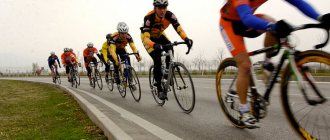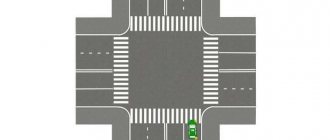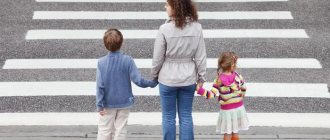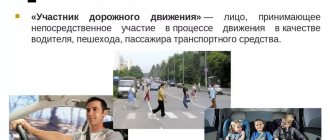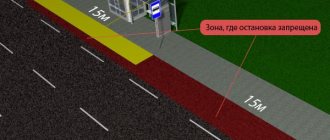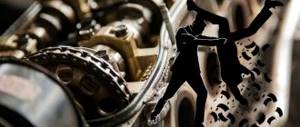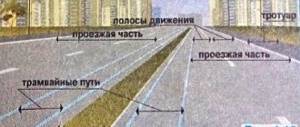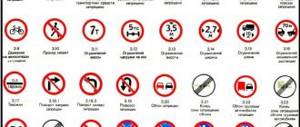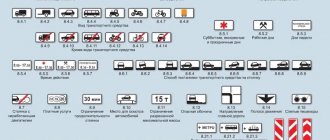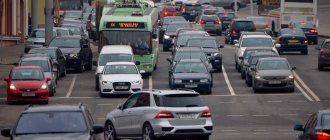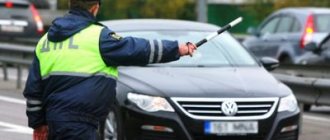General traffic rules for cyclists
The basic provisions of the riding rules for cyclists are set out in Article 24 of the Traffic Regulations, but this is not the only mention of two-wheeled vehicles in the laws. Since 2014, the concept of “bicycle path” has appeared in the rules, and ideally, citizens using this type of transport should only ride along it (Article 24.1 of the Traffic Rules) and always move onto it if one appears in their field of vision. But in fact, they are only in large cities, like Moscow or St. Petersburg, and then on busy avenues. How to cope with this problem for residents of residential areas and small provincial towns will be discussed below.
According to Article 2.3 of the Traffic Regulations, before leaving, the bicycle driver must ensure that his vehicle is fully prepared for the trip: it has working brakes, steering wheel, chassis, inflated wheels, working light signals and a bell.
It is necessary to wear protective equipment such as a helmet or knee and elbow pads. There is no legal obligation for either children or adults to wear these things, and there will be no punishment for their absence, but elementary safety considerations have not been canceled. It is better to cover your eyes with special sports sunglasses.
Should he follow traffic rules?
A bicycle is officially equated to a type of vehicle and, for traffic regulations, is not much different from a car. For this two-wheeler, all the rules that begin with “The driver must…”, “The vehicle must…”, etc. apply. A bicycle does not belong to a mechanical vehicle, so if the test is about them, then it is not for cyclists.
For violations of traffic rules, the cyclist will bear administrative responsibility on an equal basis with other road users.
Expert opinion
Evgeniy Romanov
Lawyer, specializes in protecting rights in areas related to traffic rules, insurance and disputes with the traffic police.
There is a nuance that applies only to this type of transport: if a person gets off the saddle and stands on his feet, then officially he is already a pedestrian and obeys the rules for pedestrians.
Cyclist safety
Not everyone understands that a bicycle is equal to a car, so on the road a cyclist will need to follow the general rules of movement on the roadway (regarding non-motorized vehicles).
Along with all other road users - motorists, motorcyclists, horse-drawn vehicle drivers and pedestrians - cyclists are required not only to know, but also to strictly adhere to all traffic rules relevant for 2021.
Let's look at what important factors need to be taken into account for the safe movement of cyclists.
Serviceability
First of all, the cyclist is obliged to carefully monitor the serviceability of the vehicle.
Namely, check all the most important parts of the bicycle (handlebars, working brakes), check whether it is equipped with other important parts for driving on the highway:
- reflectors (back, front, and sides);
- flashlights that work at night;
- a working bell to sound a signal.
A cyclist must highlight his bicycle on the roadway so that both the vehicle and the driver himself are clearly visible to all other road users.
Road signs
Bicycle drivers should be especially attentive to the following signs:
- priority signs;
- signs of special instructions (informing about the movement of route vehicles, one-way traffic);
- signs that indicate the direction of movement;
- signs prohibiting turns and entry.
However, the cyclist must also know all other signs and strictly observe them. While driving, the bicycle driver should also take into account road markings:
- It is forbidden to cross a solid line;
- do not stand in places that are marked in yellow;
- allow pedestrians to cross the zebra crossing.
Also, the cyclist must move correctly in a group, be extremely attentive and have good reactions.
Speed
According to traffic regulations, moving synchronously with the flow of cars is the safest option for each vehicle.
But on the road you should develop and maintain a fairly high speed, at least 20 km/h.
Sticking to this speed limit is necessary because driving too slowly can interfere with cars, as they will have to maneuver around the cyclist.
This is especially true on narrower roads, where passing oncoming and passing traffic is difficult.
It is worth noting that high speed is only justified if all other vehicles are moving quickly.
Distance
For a cyclist, distance is the distance in length between other vehicles and him.
Side spacing is the distance across the width. Safe and comfortable riding on the road requires maintaining a distance and interval so that if a dangerous situation develops, the cyclist can turn to the side.
If the distance with the car in front decreases, you will need to slow down, or vice versa - speed up if the distance decreases with the vehicle behind.
In case of parallel movement, you should not press too close to parked or passing cars, and there are good reasons for this:
- There is a chance of falling on the car as a result of an uneven road.
- The car may hit the cyclist in some way.
- The door of a stationary car may suddenly open.
So, attentiveness is the key to safe cycling. In this case, you should carefully monitor what is happening on the sides and in front.
The road is movement, so the situation can change every second. It is useful to purchase a special rear-view mirror and attach it to the steering wheel, thanks to which you can also monitor the road from behind.
Rules for cyclists
There are not so many special traffic rules specifically for cyclists and they are not as strict as for cars, but they still must be followed, especially if you ride a bicycle along country roads.
Along the roadway
The rules for driving on the roadway are regulated in Article 24.2 of the Traffic Regulations. They indicate that you can move along the highway only if there is no special bicycle path nearby or for some reason it is impossible to travel along it. The cyclist must stay strictly at the right edge of the route in the direction of flow, without driving over the strip that separates the road from the side of the road (solid line 1.2.1 or broken line 1.2.2).
When approaching a pedestrian crossing, he must slow down, let people pass and move on, just like cars.
You can also drive on the road if the vehicle has dimensions of more than one meter or is traveling with a trailer whose width is more than one meter. When a whole column of bicycles follows the road, it is permissible for it to move only in one row. You can travel in two columns as an exception if:
- The width of a bicycle with a driver is no more than 0.75 meters;
- No more than ten vehicles are moving;
- Groups with more than ten bicycles must travel in several groups of ten participants. To make overtaking easier, they should stretch out at a distance of 80-100 meters from each other.
The rules do not oblige a cyclist to move off the asphalt onto the dirt shoulder to let passing traffic pass. Motorists must understand that a bicycle is a road user like them, and not a pedestrian.
On the side of the road
According to the traffic rules, you can ride on the side of the road on the right side of the road in the direction of travel if there are no specially designated bicycle paths, sidewalks, pedestrian zones or there is an obstacle to driving along the right edge of the highway.
On the sidewalk or pedestrian path
You can ride on the sidewalk or in the pedestrian zone, if, again, there is no special bicycle path nearby and it is not possible to ride along the right edge of the highway. You also need to move exclusively on the sidewalk if a cyclist under 14 years of age is riding nearby or when transporting a child under 7 years of age in a specially adapted seat or in a stroller. A child under 7 years old must also ride a bicycle exclusively on the sidewalk, accompanied by adult pedestrians.
Paths and lanes for cyclists
Bicycle paths are lanes that are specifically designated in large cities for cycling. Ideally, cyclists should only ride on it. Riding on the sidewalk, in a pedestrian zone, on a highway and in other places not suitable for bicycles, if there is a bicycle path, is prohibited.
A bicycle path is a narrow strip with asphalt surface. Nearby there is a road sign 4.4 “Bicycle path”, or the sign is depicted directly on the asphalt. They come in both one-way and two-way traffic.
How to pass intersections on a bicycle?
The rules for driving through intersections are set out in Article 13 of the Traffic Regulations. If it is not regulated by a traffic light or a traffic controller and is equivalent, then priority in the turn will always go to the one on the right. If the road is uneven (that is, there is a sign 2.1 “Main Road”), then the one moving along the main road goes first. Vehicles on a secondary road allow a car to pass to the right of it.
This does not apply to trams - they always have priority.
If there is a traffic light or a traffic controller, then you need to obey their signals. According to Article 24.8 of the Traffic Rules, a bicycle is prohibited from turning left if the road has more than one lane. He can only move forward and to the right. If he needs to turn left, he will have to dismount and look for a pedestrian crossing to the other side of the highway.
Unfortunately, some drivers are not aware that a cyclist is a participant in the traffic just like himself, and may treat two-wheeled vehicles with disdain. This is a serious misconception.
To avoid exposing himself to unnecessary danger from ignorant drivers, it is best for a cyclist to stop in his lane and patiently wait for other road users to make their maneuver, and only when the road is clear, cross the road himself.
Maximum speed
The cyclist must adhere to the same speed limit that is indicated on the sign for all road users (clause 10.1 of the traffic rules). As a rule, in urban areas the maximum speed limit is 60 km/h; in courtyards and residential areas you cannot drive faster than 20 km/h. If it is almost impossible to exceed the first indicator on a bicycle, then breaking the second is not difficult. On the road you can find even fewer speed limits - all of them are mandatory.
If the bicycle has an electric drive, then at around 25 km/h it should turn off.
Outside the city, the speed limit is, as a rule, beyond the reach of muscle-powered vehicles, so when riding on a country road it is almost impossible for a cyclist to break the speed limit.
Traffic lights and intersections
A two-wheeled vehicle moving along a highway is one of the participants in the movement. Accordingly, at intersections controlled by traffic lights, cyclists are subject to the same rules as motorists. A cyclist has no right to drive beyond the limit line, run through a prohibiting traffic light, or turn around. He should stop before the intersection and wait until the entire column receives the permission signal.
Maneuvering signals and lighting devices
In accordance with Article 8.1 of the Traffic Regulations, a vehicle is required to give signals to start moving, turn, change lanes, brake and stop. Unlike cars, bicycles are not equipped with lights, and the rules require cyclists to signal with their hands when maneuvering.
Nobody forbids installing special equipment with light signals on a bicycle. This way you can significantly facilitate your own movement on the roads.
- Turn left: extend your left arm to the side, or bend your right arm at a right angle and move it to the side;
- Turn to the right: extend your right arm to the side, or bend your left arm at a right angle and move it to the side;
- Stop: raise your left or right hand up.
All these signals should be followed a couple of seconds before starting the maneuver. It is important that other road users can see your sign and react in advance. After the signal is given and you are sure that the drivers have had enough time and opportunity to see it, you can return your hand to the steering wheel and turn.
Avoid performing these signals along with braking with one hand on the handlebars to avoid being thrown out of the saddle.
If the driver of a vehicle moves in the dark, then according to Article 19.1 of the Traffic Regulations, he must have reflective elements with him. For cyclists - reflectors and a flashlight. The white reflector needs to be attached to the front along with the flashlight on, and the red one to the back. It's also a good idea to have reflectors on wheels and wear a jacket with reflective stickers.
Article 19.5 imposes an obligation on drivers to turn on their lights during daylight hours to indicate traffic on the highway. In theory, this also applies to bicycles, but in fact this is not observed on the roads.
For cyclists under 14 years of age
Cyclists under 14 years of age must travel exclusively on the sidewalk or bike path, and only within pedestrian zones. There should not be a situation on the road where a child is driving on the road and his parent is driving on the sidewalk. And vice versa is also prohibited.
On country roads, where there is neither a bike path nor a pedestrian zone, children under 14 years of age are not allowed to ride bicycles, no matter whether there is an adult nearby or not.
A child under 7 years old on a bicycle must be accompanied by adult pedestrians on sidewalks or pedestrian paths. You cannot accompany him on your own bicycle either.
How to use transition?
If there is an urgent need to cross the road, the rules allow cyclists to use the pedestrian crossing, but only after dismounting. The bicycle must be kept close to you. If a person gets off his bike, he turns from a driver into a pedestrian, and his legal status changes. And now he has undeniable priority at the pedestrian crossing.
However, in accordance with Article 24 of the Traffic Regulations, cyclists are allowed to ride on sidewalks, and this is one of the exceptions that distinguishes bicycles from motor vehicles. True, a cyclist cannot always move there, but only in the following cases: “there are no bicycle and bicycle pedestrian paths or there is no opportunity to move along them, and there is also no opportunity to move along the right edge of the roadway or shoulder; the cyclist accompanies a cyclist under 14 years of age or transports a child under 7 years of age in a booster seat, in a bicycle stroller or in a trailer designed for use with a bicycle.”
They're frankly annoying! 10 things cyclists do that drive us crazy Read more
In addition, if a cyclist has not reached the age of 14, he cannot ride on the roadway, but can only ride on the sidewalk. However, in this case it is important not to forget about the safety of pedestrians. In accordance with paragraph 24.6, “if the movement of a cyclist on a sidewalk, pedestrian path, shoulder or within pedestrian zones endangers or interferes with the movement of other persons, the cyclist must dismount and follow the requirements provided for by these Rules for the movement of pedestrians.”
If the cyclist was careless and caused harm to a pedestrian, then he is liable before the law as the driver of a vehicle. The problem is that cyclists do not have compulsory motor insurance, and the damage resulting from an accident can be serious. For example, when driving on the sidewalk, a cyclist will hit a person, after which hospitalization will be required.
OSAGO could cover the costs of treatment and recovery, but there is no insurance, and the dispute between the participants in this accident is completely under the jurisdiction of the courts. Victims can bring serious claims against the person responsible for the accident.
There is also a fine for cyclists, although only one. According to Article 12.29 of the Code of Administrative Offenses of the Russian Federation, for any violation of the Traffic Rules by a person driving a bicycle, an administrative penalty is imposed in the form of a fine in the amount of 800 rubles.
Cyclist privileges
Recently, cyclists have received an advantage: they are allowed to move in a dedicated lane for route vehicles. Such roads are indicated by blue road signs (5.11, 5.13.1, 5.13.2, 5.14). Apart from passenger taxis, school buses and bicycles, no type of transport is allowed to appear on it. However, there is a nuance: a cyclist can only enter it if it is located on the right and there are no bicycle paths nearby.
Cyclists are prohibited
- Driving a vehicle without hands on the steering wheel - reckless driving and driving with just your legs are unacceptable;
- Drive with a load that extends beyond the dimensions by more than 0.5 meters in any direction or interferes with control;
- Transport passengers on a frame, on a trunk or in any other way that is not provided for by the design;
- Transport a child without a specially equipped seat;
- Drive along pedestrian crossings;
- While in the right traffic, turn around or turn left on tram lines, or on a highway with two or more lanes - unless there is a special sign on the road allowing a turn or if the road does not pass in a special bicycle zone;
If you urgently need to turn left, you can get off your bike and, like an ordinary pedestrian, cross to the other side of the road along the zebra crossing, driving traffic nearby.
- Tow another bicycle (if there is no special towing trailer on which another vehicle is securely attached);
- Drive on highways;
- Talk on the phone while holding the steering wheel with one hand.
Crime and Punishment
Article 12.29 of the Traffic Regulations tells what awaits violators.
- Crossing the roadway along a zebra crossing by a dismounted cyclist, interfering with the movement of pedestrians and/or the passage of any vehicles can be forgiven only for the first time, at the discretion of the police officer. Repeated warning entails a fine of 200 rubles.
- Violation of traffic rules by a drunk cyclist is punishable by a monetary penalty in the amount of 300 to 500 rubles.
So that your actions do not create interference on the roadway, do not irritate car drivers, and even worse - so that you do not hit someone crossing the road, you need to remember a simple rule: a cyclist can only cross, but not cross the road at a pedestrian crossing.
Fines for cyclists and common mistakes
Now let's talk about how not to ride a bike.
Drunk on a bike
A bicycle is also a type of vehicle that can pose a danger to others, and the person in the saddle is its driver. Accordingly, if you appear on it while intoxicated, this will be considered a violation of Article 2.7 of the Traffic Regulations, which directly prohibits driving any vehicle while drunk.
It is also not allowed to hand over control to a drunk person. In this case, the owner of the bicycle will also be responsible.
When is it prohibited to use a bicycle?
It is prohibited to cross the road along the pedestrian crossing while riding a bicycle. Only people can move along them on foot, so if a cyclist needs to cross the zebra crossing, he will have to dismount and go through the crossing, driving his vehicle nearby. This is especially true for areas that are not controlled by traffic lights.
This ban applies primarily for the safety of the cyclist himself, since a cyclist is not able to stop abruptly with the same success as a pedestrian. In addition, he, as a rule, moves faster than a person, and there is a high probability of not noticing an approaching car.
You should also not drive if the bicycle has faulty or no brakes. Among young people, dismantling “extra and heavy” brakes is a common practice that runs counter to Article 2.3.1 of the Traffic Regulations, which obliges the driver to have a working brake system.
Also, according to paragraph 6 of the “Basic provisions for the approval of a vehicle for operation”, you cannot drive a bicycle if the steering wheel is broken, the sound signal is broken, there are no reflectors in the front, rear and sides for riding at night.
If the movement of a cyclist threatens other road users or creates a danger for persons in pedestrian areas, then he must dismount and continue moving as a pedestrian.
Can a bicycle overtake?
A cyclist can overtake other vehicles, but he has the right to do this only under Article 11 of the Road Rules, which regulates safe overtaking. You can overtake other cars if:
- The cyclist is confident that the road ahead is clear and he will not create a danger for other vehicles;
- Overtakes on the left side;
A cyclist is prohibited from overtaking if:
- The vehicle in front begins to overtake itself or goes around an obstacle;
- The vehicle is turning left or has just turned on the left turn signal;
- A safe return to the runway is not possible.
Overtaking is prohibited at pedestrian crossings, at railway crossings and within one hundred meters of them, on and under bridges, tunnels, controlled and unregulated intersections, unless the cyclist is traveling on the main road, as well as in places with poor visibility.
How to transport a child on a bicycle
A child can be transported on a bicycle in two cases:
- The manufacturer's design includes a special seat with seat belts and a handle;
- It has a trailer or stroller mount that you can safely place your child in.
Transporting children on a frame, trunk, on a makeshift seat or stroller is strictly prohibited.
Fine for violating traffic rules by a cyclist
A cyclist may be fined:
- For driving while intoxicated under Article 12.29, paragraph 3 of the Code of Administrative Offenses of the Russian Federation - from 1,000 to 1,500 rubles;
- Violation of traffic rules under Article 12.29 clause 2 of the Code of Administrative Offenses of the Russian Federation – 800 rubles;
- Interference with other road users under Article 12.30 clause 1 of the Code of Administrative Offenses of the Russian Federation – 1,000 rubles.
- Harm to human health under Article 12.30 clause 2 of the Code of Administrative Offenses of the Russian Federation - from 1,000 to 1,500 rubles.
- Talking on a mobile phone while driving under Article 12.36 of the Code of Administrative Offenses of the Russian Federation – 1,500 rubles.
Basic Rules
When performing maneuvers on a bicycle, the child must correctly assess the situation and avoid obstacles in a timely manner. Parents need to train their child to develop the skill of viewing the area and controlling a bicycle at the same time.
For safety reasons, the following rules must be observed:
- It is not recommended to listen to music through headphones while driving;
- You cannot speed up in places where there are large crowds of people;
- it is necessary to sound signals using a bell to warn pedestrians about the maneuver;
- you need to go around holes, cracks, puddles, glass and stones;
- You cannot move from the sidewalks onto the roadway;
- Do not let go of the steering wheel while driving;
- You shouldn’t turn your attention to extraneous things, you need to focus on driving the bike.
Parents need to instill in their children the habit of caring for their personal vehicles, inspecting them every time before a trip and teaching them how to repair minor damage.
Road signs
Basic road signs for cyclists:
Bike Lane
This sign indicates a bike path. If the strip of asphalt along the road is not marked with this sign, then it is simply a shoulder on which cyclists are allowed to move, or it is a sidewalk on which cyclists are prohibited from moving.
Bicycles are prohibited
Bicycles are prohibited under this sign.
Overtaking
Adult cyclists are full road users, so they can overtake other vehicles. To avoid accidents and injuries, follow these simple tips:
- Before overtaking, you need to slow down so that the driver has time to notice you.
- When overtaking parked cars, keep in mind that the door may suddenly open and this will inevitably lead to a collision. Don't drive too close to cars.
- It is forbidden to overtake moving vehicles on the right because you could be hit by oncoming traffic.
It must be taken into account that a car standing still can start moving. Therefore, a cyclist always needs to be visible.
Driving through intersections
It is important for each road user to distinguish between the types of intersecting roads and to know the rules for driving along them.
- Uncontrolled intersection Before turning right, first let cars coming from there pass. Before turning left, let all traffic moving in the oncoming lane pass.
- Priority Intersection This section is formed by the intersection of a main and secondary road. When driving along the first road, the cyclist has the right of way, but when approaching the intersection, he should slow down, since no one can guarantee that other drivers will comply with traffic rules. If you must turn left, give way to vehicles coming from all directions.
- Signalized intersection At the traffic light, you can drive straight or go right. Driving to the left is prohibited, since the traffic rules provide for the movement of cyclists only in the far right lane or on the side of the road.
Driving near obstacles
Cyclists don't always have to ride in open areas. If you drive near trees, bushes or through tunnels, be sure to sound your horns. This way you will warn pedestrians and motorists that you are approaching. This rule can be applied when driving around a corner.
For children
Children under 7 years old are allowed to ride exclusively on the sidewalk; after 7 years old, young cyclists can move along special paths, but in the presence of their parents. Before your first trip, you need to learn the driving rules for children:
- The student must give way to passers-by.
- You must not remove your hands from the steering wheel, your feet from the pedals, or carry passengers on a bicycle.
- Before each use, the bicycle must be inspected in order to promptly identify faults.
- When driving, you must maintain a distance and be able to avoid passers-by.
- You should wear protective equipment before every trip.
The seat of a new bicycle must be adjusted so that the child reaches the pedal in the lower position with a straight leg. To prevent the student from colliding with passers-by at night, reflectors must be installed on the vehicle: white in front, red in back, orange on the side. You will also need a bell, headlight or flashlight.
A helmet for a child should be selected not according to his height, but according to the size of his head. It must not be allowed to slide into your eyes. It is best to purchase a bright helmet with reflectors. This will ensure that the baby is visible to all road users even at dusk. The helmet can also be equipped with a flashlight.
Hands, elbows and knees must be protected with special equipment - gloves, knee pads and elbow pads.
The child should wear light and breathable clothing so that he does not overheat while riding. It is unacceptable to pedal while wearing pants that are too long or too wide; getting them wrapped around the chain will cause you to fall. Shoes should be comfortable and fit well on your feet.
How to behave in case of an accident
The algorithm of actions is described in Article 2.5-2.6 of the Traffic Regulations. If a cyclist does become involved in an accident, he should:
- Make sure that you remain intact and there are no serious wounds; if someone else is injured, call an ambulance by calling 103 or 112;
- If he collides with a car, the driver must put up a warning triangle and turn on the hazard warning light;
- Do not touch the bicycle - let it lie where it fell;
- If you need to receive compensation for the repair of your vehicle, call the traffic police at 102;
- While the inspector is driving, take out your smartphone and take a photo of the bicycle and the other participant in the accident - this will help the arriving traffic police officer to reconstruct the picture of the events;
- Once all the photos have been taken, the bike can be removed from the road if it is obstructing traffic;
- As soon as the traffic police car arrives, report your version of events and ensure that it is correctly reflected in the protocol;
- The inspector must draw up a report and give a copy of it, along with a certificate of the accident, to the participants in the accident. These papers will be needed if the case goes to court.
In Russia, where bike paths have only recently begun to appear, riding through a densely populated city can be quite an adventure, and it is not always possible to strictly follow the rules. It is unlikely that anyone will actually impose fines if a cyclist rides on the wrong side of the road. But keeping legislative norms in mind is important and necessary when controversial situations arise and to protect your rights.
Is damage covered by insurance?
In case of an accident with a cyclist, you can receive compensation provided by the MTPL policy. The injured party applies for it with a completed application and a collected package of documents. It includes the following:
- Identity passport.
- Notice.
- Decree on road accident.
- Certificate from the traffic police.
- Bank account number.
- Extract from the hospital card.
Attention! If the accident was fatal, then relatives or legal representatives of the deceased receive compensation for the damage received. If payment is refused, the victim has the right to go to court to protect his rights. All the listed documents, as well as a written refusal from the insurance operator, are attached to the statement of claim.
Accidents involving cyclists are not uncommon, as these road users often break the rules out of ignorance. This often happens at intersections, when drivers of two-wheeled vehicles forget that on this section of the road they are ordinary pedestrians and are obliged to move with everyone else along the zebra crossing, holding the bicycle with their hands. The punishment for the offense directly depends on the circumstances of the case and the state of the parties at the time of the collision. Alcohol intoxication results in deprivation of rights.
